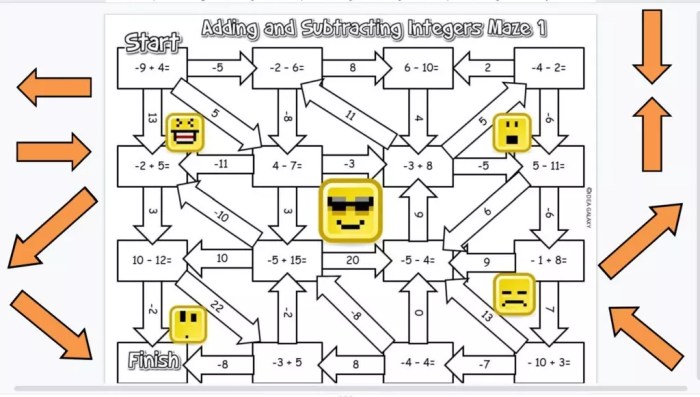Unlock the secrets of integer operations with the comprehensive Adding and Subtracting Integers Answer Key. This definitive guide empowers you to conquer the complexities of positive and negative numbers, equipping you with the knowledge and skills to excel in mathematical endeavors.
Delve into the fascinating world of integers, where numbers dance between the realms of positive and negative, revealing the intricacies of adding and subtracting these enigmatic values. Discover the rules that govern these operations, unraveling the mysteries that lie within.
1. Introduction to Adding and Subtracting Integers

Integers are positive and negative numbers that represent quantities. They are used to describe a wide range of values, such as temperatures, altitudes, and financial transactions. Adding and subtracting integers is a fundamental operation in mathematics that allows us to solve problems involving these quantities.
Examples of Adding and Subtracting Integers in Daily Life
- Calculating the change in temperature: If the temperature drops by 5 degrees, we can represent this as -5. Adding this to the current temperature gives us the new temperature.
- Determining the balance in a bank account: If you deposit $100, we can represent this as +100. If you then withdraw $50, we can represent this as -50. Adding these values gives us the current balance.
2. Rules for Adding and Subtracting Integers
Adding Two Integers with the Same Sign
When adding two integers with the same sign, simply add their absolute values. The sign of the result is the same as the signs of the original integers.
Adding Two Integers with Different Signs
When adding two integers with different signs, subtract the absolute value of the smaller integer from the absolute value of the larger integer. The sign of the result is the same as the sign of the integer with the larger absolute value.
Subtracting an Integer
Subtracting an integer is the same as adding its opposite. For example, subtracting 5 is the same as adding -5.
3. Methods for Adding and Subtracting Integers
There are several methods for adding and subtracting integers. One common method is to use a table:
| + | – | |
|---|---|---|
| + | + | – |
| – | – | + |
Another method is to use a flowchart:

4. Examples and Practice Problems: Adding And Subtracting Integers Answer Key
Examples
- 3 + 5 = 8
- -7 + 2 = -5
- -4 – 6 = -10
Practice Problems
- Find the sum of 10 and
5.
- Subtract 8 from
12.
- Find the difference between
15 and 7.
5. Applications of Adding and Subtracting Integers
Real-Life Applications, Adding and subtracting integers answer key
- Temperature changes
- Financial transactions
- Calculating distances
- Solving physics problems
- Engineering calculations
- Economic modeling
FAQ Insights
What is the rule for adding two integers with the same sign?
Add the absolute values of the integers and keep the common sign.
How do I subtract an integer?
To subtract an integer, add its opposite (or additive inverse).
Can you provide an example of adding and subtracting integers in daily life?
Calculating temperature changes (e.g., adding 5 degrees to 20 degrees Celsius) or determining financial gains and losses (e.g., subtracting $100 from a $500 budget).

